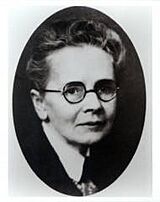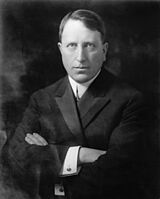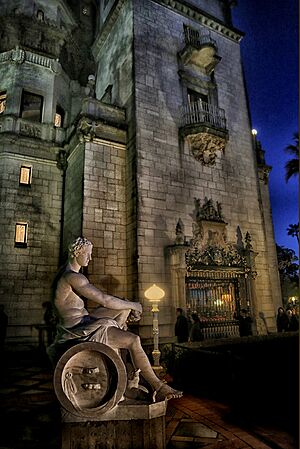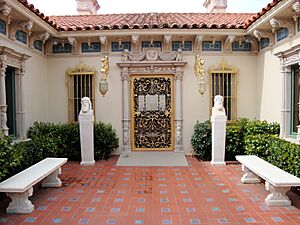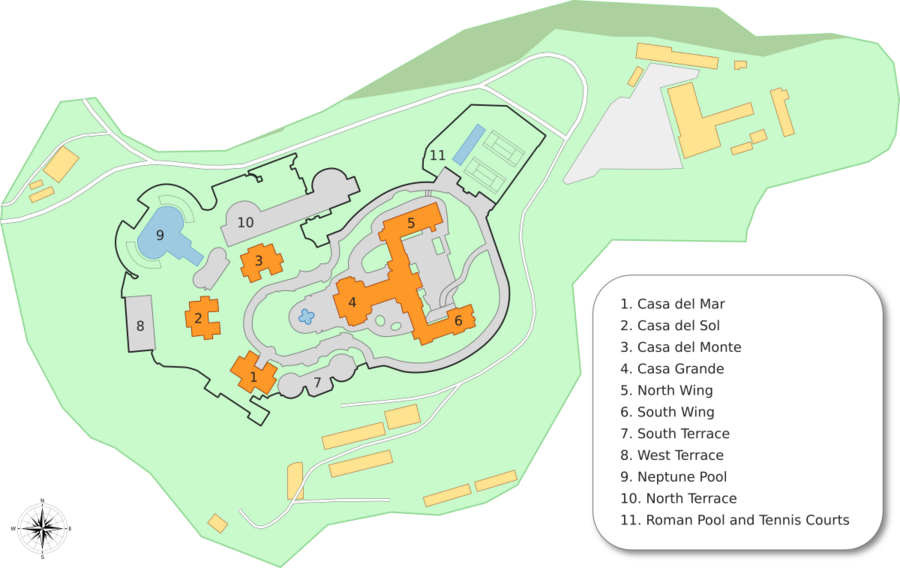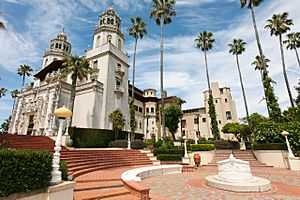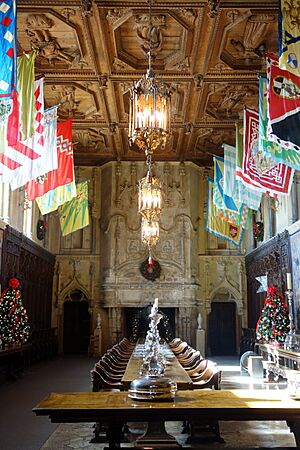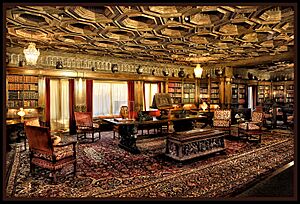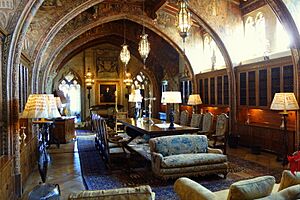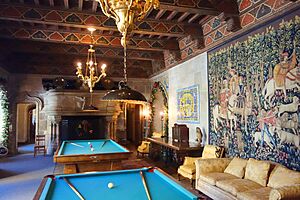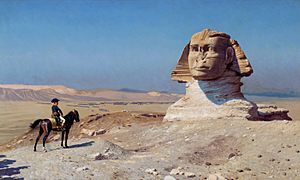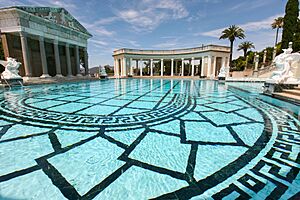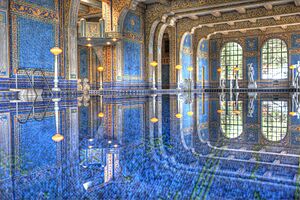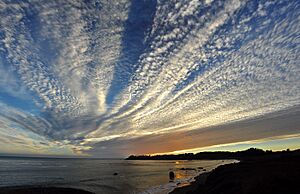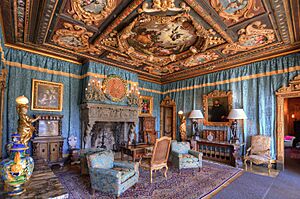Hearst Castle facts for kids
|
Hearst Castle
La Cuesta Encantada |
|

Casa Grande, inspired by the Church of Santa María la Mayor, Ronda, Spain, forms the centerpiece of Hearst's estate.
|
|
| Nearest city | San Simeon, California, United States |
|---|---|
| Area | More than 90,000 sq ft (8,400 m2) |
| Built | 1919–1947 |
| Architect | Julia Morgan |
| Architectural style | Spanish Colonial Revival, Mediterranean Revival, other late 19th and 20th century revival styles |
| NRHP reference No. | 72000253 |
Quick facts for kids Significant dates |
|
| Added to NRHP | June 22, 1972 |
Hearst Castle, also known as La Cuesta Encantada (which means "The Enchanted Hill" in Spanish), is a famous historic estate in San Simeon, California. It's located on the beautiful Central Coast of California. This amazing castle was dreamed up by William Randolph Hearst, a very successful newspaper owner, and designed by his talented architect, Julia Morgan. It was built between 1919 and 1947.
Today, Hearst Castle is a museum that welcomes visitors as a California State Park. It's also recognized as a National Historic Landmark and a California Historical Landmark.
William Randolph Hearst's father, George Hearst, bought the land for the estate in 1865. The spot where the castle now stands, called Camp Hill, was used for family camping trips when William Randolph was a boy. After his mother, Phoebe Hearst, passed away in 1919, William Randolph asked architect Julia Morgan to build "something a little more comfortable up on the hill." This was the start of the castle we see today.
Julia Morgan worked closely with Hearst for over twenty years. Construction on the castle was almost continuous from 1920 until 1939. Work started again after World War II and continued until Hearst left in 1947.
Hearst Castle was meant to be a family home. By 1925, William Randolph Hearst and his partner, actress Marion Davies, often hosted many famous guests. These included Hollywood stars like Charlie Chaplin, Cary Grant, the Marx Brothers, Greta Garbo, Buster Keaton, Mary Pickford, Jean Harlow, and Clark Gable. Important political figures like Calvin Coolidge and Winston Churchill also visited. Other notable guests included Charles Lindbergh and Bernard Shaw.
William Randolph Hearst loved collecting things so much that people called him the "Great Accumulator." He wanted the castle to be "a museum of the best things that I can secure." He bought many architectural pieces from Europe, especially Spain. These included ceilings, doorways, fireplaces, and even parts of old monasteries. These items were shipped to California and built into Hearst Castle. He also collected high-quality art and antiques, including one of the world's largest collections of ancient Greek vases. The castle and Hearst's lifestyle were featured in the 1941 film Citizen Kane.
In May 1947, William Randolph Hearst's health made him leave the castle for the last time. He passed away in Los Angeles in 1951. Julia Morgan passed away in 1957. The next year, the Hearst family gave the castle and many of its treasures to the State of California. The mansion opened to the public in June 1958. It is now called the Hearst San Simeon State Historical Monument and attracts about 750,000 visitors each year. The Hearst family still owns most of the larger 82,000-acre estate. They have worked with the California State Parks Department to keep the area natural and undeveloped.
History of Hearst Castle
Early Days: Before 1865
The coastal areas of Southern California have been home to people for a very long time. The first people here were the Salinans and the Chumash. In the late 1700s, Spanish missions were built to teach the Native American people. Mission San Miguel Arcángel, a large mission, opened in 1797.
By the 1840s, the missions were not as active. During this time, Mexican California leaders gave out mission lands as grants. Three of these were Rancho Piedra Blanca, Rancho Santa Rosa, and Rancho San Simeon. After the Mexican–American War (1846–1848), the United States took control of the area. The California gold rush in the 1850s brought many new settlers, including George Hearst.
How the Land Was Bought: 1865–1919
George Hearst was born in Missouri in 1820. He became rich from mining, especially at the Comstock Lode. He later became a senator in 1886 and bought The San Francisco Examiner newspaper. He started buying land in California, including the Piedra Blanca property in 1865. He later bought more land, including parts of the Santa Rosa and San Simeon estates.
In the 1870s, George Hearst built a ranch house on the estate. The San Simeon area became a favorite spot for family camping trips, including for his young son, William. A special place was called Camp Hill, which is where Hearst Castle would later be built. William Randolph Hearst remembered these early days, saying, "My father brought me to San Simeon as a boy... I could see forever." George Hearst improved the estate by raising cattle, planting fruit trees, and expanding the docks at San Simeon Bay. He also bred racehorses.
While his father worked on the ranch, William and his mother traveled. They went on a long trip to Europe in 1873, which sparked William's lifelong interest in collecting art.
When George Hearst passed away in 1891, he left his wife, Phoebe Hearst, $18 million, including the California ranch. Phoebe Hearst also loved art and supported architects. She was a generous giver, starting schools and libraries, and helping the University of California, Berkeley. During this time, she met Julia Morgan, a young architecture student. When Phoebe Hearst passed away in 1919, William inherited the ranch, which had grown to 250,000 acres and 14 miles of coastline, along with $11 million. Soon after, he visited Julia Morgan's office.
Morgan and Hearst: A Great Team
Julia Morgan, born in 1872, was 47 when Hearst came to her office in 1919. She is known as "America's first independent full-time woman architect." She studied at Berkeley and then became the first woman to get into the famous École des Beaux-Arts in Paris in 1898. After finishing her studies in 1902, Morgan returned to San Francisco. In 1904, she became the first woman to pass California's architecture licensing exam and opened her own office.
William Randolph Hearst was 56 in 1919. He owned a huge media company with many newspapers, magazines, radio stations, and film studios. He was a very influential public figure.
Morgan and Hearst worked together on San Simeon from 1919 until he left the castle in 1947. They exchanged thousands of letters and telegrams. Their partnership is described as "a rare, true collaboration." People who knew them said they worked together very well.
Fun Times at the Castle: 1925–1938

Hearst and his family first stayed in Casa Grande for Christmas in 1925. From 1926 until 1947, Marion Davies was the hostess at the castle. Many famous people from Hollywood and government visited in the 1920s and 1930s. Guests included Calvin Coolidge, Winston Churchill, Charlie Chaplin, Cary Grant, the Marx Brothers, Charles Lindbergh, Jean Harlow, and Clark Gable.
Guests usually arrived on Friday evening or Saturday. They either took a private train from Los Angeles and then a car, or flew into Hearst's private airstrip. Cecil Beaton described his first visit in 1931: "we caught sight of a vast, sparkling white castle in Spain. It was out of a fairy story."
During the day, guests could enjoy horse-riding, swimming, golf, croquet, and tennis. Hearst sometimes led groups for picnics on the estate. Everyone gathered for cocktails in the assembly room at 7:30 on Saturday night. Dinner was served at 9:00 in the refectory. After dinner, guests watched a movie, usually from Hearst's own studio, Cosmopolitan Productions. These often starred Marion Davies.
In 1937, Patricia Van Cleeve got married at the castle. She was introduced as Marion Davies' niece, but it was often rumored that she was actually Davies and Hearst's daughter. She confirmed this herself before she passed away in 1993.
The Castle in Movies: Citizen Kane
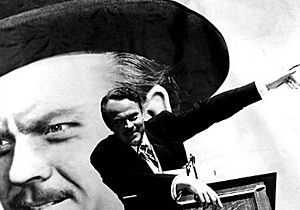
Hearst Castle was the inspiration for the fictional estate called Xanadu in Orson Welles's 1941 film Citizen Kane. The movie tells the story of Charles Foster Kane, a powerful media owner. The film shows his castle in Florida, filled with countless treasures.
Filming for Citizen Kane began in June 1940, and the movie premiered in June 1941. Although Welles and the film studio denied it at the time, many believed the film was based on Hearst. Hearst tried very hard to stop the movie from being released. When he couldn't, he used his newspapers to attack the film and Welles. This hurt the movie's success at the box office and affected Welles's career.
Despite this, Citizen Kane has been called one of the greatest films of all time. In 2012, the film was shown in the movie theater at Hearst Castle for the first time as part of the San Luis Obispo International Film Festival.
Later Years and Public Opening: 1939–Present
By the late 1930s, the Great Depression and Hearst's spending led to financial difficulties. He had to give up control of his company, sell newspapers, and many of his art pieces. Construction at Hearst Castle mostly stopped. After Pearl Harbor, the castle closed, and Hearst and Davies moved to another estate. They returned in 1945, and limited construction continued until 1947. In May 1947, Hearst and Davies left the castle for the last time due to his declining health. Hearst passed away in 1951. Julia Morgan closed her office in 1950 and passed away in 1957.
In 1958, the Hearst Corporation gave Hearst Castle, its gardens, and many of its contents to the state of California. A plaque at the castle says it was given "in memory of William Randolph Hearst who created this Enchanted Hill, and of his mother, Phoebe Apperson Hearst, who inspired it." The castle opened to the public in June 1958.
Hearst Castle was added to the National Register of Historic Places in 1972 and became a United States National Historic Landmark in 1976. William Randolph Hearst always wanted to protect the special feeling of his castle. He once wrote that "wild movie people" wanted to film there, but he said, "they are NOT going to be allowed to do this..." Even today, commercial filming at the castle is rare.
On December 22, 2003, an earthquake with a magnitude of 6.5 happened near the castle. The castle's strong construction meant there was very little damage. Since it opened, the castle has become a major California tourist spot, attracting over 850,000 visitors in 2018. The Hearst family still has a connection to the castle. For example, it closed for a day in August 2019 for the wedding of Amanda Hearst, William Randolph Hearst's great-granddaughter.
The castle closed in March 2020 because of the COVID-19 pandemic. During this time, many repairs and projects were completed that would have been hard to do with visitors around. The castle reopened on May 11, 2022.
Architecture of Hearst Castle
Castle Design
Hearst first talked to Julia Morgan about building something new in April 1919. He said he was "getting a little too old" for camping in tents and wanted "something that would be a little more comfortable."
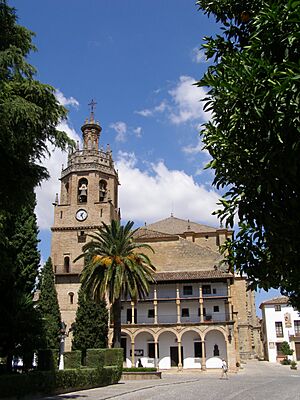
Within a month, Hearst's ideas for a small home grew much bigger. They considered different styles, eventually choosing the Spanish Colonial Revival style. Hearst liked this style but wanted something more grand. His trips to Europe, especially Spain, gave him ideas from Renaissance and Baroque buildings. He particularly liked a church in Ronda, Spain, and asked Morgan to design the Casa Grande towers like it.
This mix of Southern Spanish Renaissance, Revival, and Mediterranean styles became the unique look of San Simeon. It was "something a little different than other people are doing out in California." Experts describe Casa Grande as a "palatial fusion of Classicism and Mediterranean architecture."
Hearst Castle has 42 bedrooms, 61 bathrooms, 19 sitting rooms, 127 acres of gardens, indoor and outdoor swimming pools, tennis courts, a movie theater, an airfield, and once, the world's largest private zoo. Hearst often changed his mind about designs. For example, the Neptune Pool was rebuilt three times. Because of Hearst's changes and financial challenges, the castle was never fully finished. Construction started in 1919 and continued until 1947.
Building the Castle
The castle's location made building it very challenging. It was far away from cities. Julia Morgan would travel for eight hours by train and then 50 miles by car to get there. This made it hard to find and keep workers.
In the early years, the estate didn't have much water. This problem was solved by building three reservoirs. Morgan designed a system to bring water from nearby mountain springs to the reservoirs. Water was important for the pools and fountains, and it also powered a private hydroelectric plant until 1924.
The weather was another challenge, with strong winds from the Pacific Ocean and frequent winter storms.
Water was also needed to make concrete, which was the main building material. Morgan had a lot of experience with steel-reinforced concrete. They used stone from the mountain where the castle was built, mixed with desalinated sand from San Simeon Bay, to make very strong concrete. Later, white sand was brought from Carmel. Building materials came by train, truck, or ship to a wharf built in San Simeon Bay. A small railway was built from the wharf to the castle.
Brick and tile factories were also set up on site because bricks and tiles were important for the castle's decoration. Morgan worked with several tile companies. Artists like Albert Solon and Frank Schemmel came to the castle to do tiling work. Camille Solon, Albert's brother, designed the beautiful mosaics in the Roman pool and the murals in Hearst's Gothic library.
Building Costs
The exact cost of Hearst Castle is not fully known. Estimates for building and furnishing the complex between 1919 and 1947 are around $7.2 to $10 million. Hearst often used his company's money for personal purchases, which made it hard to keep clear records.
In 1945, Julia Morgan provided a breakdown of construction costs. Casa Grande cost about $2,987,000, and the guest houses cost $500,000. Other projects, like the Neptune Pool, added to the total, bringing it to about $4,717,000. Morgan's fees for over twenty years of work were $70,755. She was not focused on making a lot of money. During Hearst's financial troubles, she wrote to him, "There never has been nor will there be, any charge in this connection, [it is] an honor and a pleasure."
Castle Layout
Guest Houses
Casa del Mar
Casa del Mar, the largest guest house, was where Hearst stayed until Casa Grande was ready in 1925. He also stayed there during his last visit in 1947. Casa del Mar has 5,350 square feet of space. The guest houses were luxurious but didn't have kitchens. Guests had to go to the main castle for breakfast. Next to Casa del Mar is a decorative wellhead that Hearst moved from his mother's estate.
Casa del Monte
Casa del Monte was one of the first guest houses built by Morgan between 1920 and 1924. Hearst wanted to start with the main house, but Morgan convinced him to build the smaller guest cottages first because they could be finished faster. Each guest house looks like a single story from the front, but has more levels going down the hillside. Casa del Monte has 2,550 square feet of living space.
Casa del Sol
Casa del Sol has a Moorish style, with beautiful antique Persian tiles. A bronze copy of Donatello's David stands on a Spanish fountain. The idea for the fountain came from a book about Spanish architecture. The house is 3,620 square feet. Morgan's team carefully cataloged Hearst's art collection. They would photograph items, give them a number, and write a description. Hearst would then choose items from these albums to furnish the rooms.
Casa Grande: The Main House
Construction of Casa Grande began in April 1922 and continued until Hearst left in May 1947, but it was never fully finished. Casa Grande is 68,500 square feet. The main front has four stories. The entrance, inspired by a gateway in Seville, has twin bell towers like a church in Santa Maria la Mayor. The main building was originally shaped like a "T." Later additions changed the design.
The main material is concrete, but the outside is covered in stone from Utah. There are balconies on the second and third floors. A large wooden overhang made of Siamese teak, originally meant for a ship, decorates the top. The bell towers contain the Celestial suites and two cupolas.
A unique feature of Casa Grande is that it doesn't have grand staircases. You reach the upper floors by elevators or stairwells in the corner towers. The terrace in front, called Central Plaza, has a pond with a statue of Galatea on a Dolphin. The doorway into Casa Grande mixes old antiques with new reproductions. A 16th-century iron gate from Spain is topped with a matching grille made in the 1920s.
The castle had advanced technology for its time. Casa Grande had an early sound system that played music from a phonograph in the basement through speakers in different rooms. Guests could also listen to six radio stations. The entire estate had 80 telephones, operated by a switchboard 24 hours a day.
Assembly Room
The assembly room is the castle's main reception room. It's described as "one of San Simeon's most magnificent interiors." The large fireplace is from a French chateau. The ceiling is from an Italian palace. A hidden door next to the fireplace allowed Hearst to enter from an elevator connected to his private suite. The assembly room, finished in 1926, is nearly 2,500 square feet.
The room displays some of Hearst's best tapestries, including ones showing the Roman general Scipio Africanus. The room also has the only Art Nouveau piece in the castle, an Orchid Vase lamp made by Tiffany. Hearst placed it there to honor his mother, who bought it.
Refectory Dining Hall
The refectory was the castle's only dining room, built between 1926 and 1927. The wooden seats along the walls are from a cathedral in Spain. The silk flags are from Siena, Italy. Hearst and Morgan chose an Italian Renaissance ceiling from around 1600. The room's style is Gothic, different from the Renaissance assembly room. The refectory was said to be Morgan's favorite room. The large central table could seat 22 people and held some of Hearst's finest silverware.
Library
The library is on the second floor, above the assembly room. The ceiling is 16th-century Spanish. The fireplace is the largest Italian one in the castle. It's made of limestone and is very old. The room holds over 5,000 books, with another 3,700 in Hearst's study. Many of the library's collections were sold in the late 1930s and early 1940s. The library also displays many of Hearst's important antique Greek vases.
Cloisters and Doge's Suite
The cloisters are a group of four bedrooms above the refectory, completed in 1925–1926. The Doge's Suite, above the breakfast room, was used by Millicent Hearst when she visited. The room has blue silk walls and a Dutch painted ceiling. Morgan also included an original Venetian loggia (a covered walkway) as a balcony. The suite connects to Morgan's clever North and South Duplex apartments, which have sitting areas and bathrooms on the main level and bedrooms upstairs.
Gothic Suite
The Gothic Suite was Hearst's private apartment on the third floor. He moved there in 1927. It includes his Gothic study (library) and his Gothic bedroom and sitting room. The bedroom ceiling is a beautiful 14th-century Spanish piece. The study's ceiling and walls were painted with frescoes by Camille Solon. The study, finished in 1931, features a portrait of Hearst at age 31.
Celestial Suites
The Celestial bedrooms, with a shared sitting room, were built between 1924 and 1926. They are located in the bell towers. The sitting room has an important painting from Hearst's collection, Bonaparte Before the Sphinx (1886) by Jean-Léon Gérôme. The suites are connected outside by a walkway called the celestial bridge, which has colorful tiles.
North and South Wings
The North (billiard) and South (service) wings were started in 1929. The North Wing has the billiard room on the first floor, with an antique Spanish ceiling and a French fireplace. It also holds the oldest tapestry in the castle, a 15th-century Millefleur hunting scene from Flanders. The theater, next to the billiard room, was used for plays and showing movies from Hearst's studio. It could seat 50 guests.
The upper floors of the North Wing were never fully completed. The service wing contains the kitchen, with modern stainless steel equipment. This wing also has more bedrooms, a staff dining room, and leads to a large basement with a wine cellar, pantries, and a barber shop for guests.
Unfinished Plans
Hearst and Morgan planned a large ballroom to connect the North and South wings at the back of Casa Grande, but it was never built. Hearst imagined it as "A great ballroom and banqueting hall." Other planned structures that were never built included two more guest houses in English and Chinese styles.
Castle Collections
Hearst was a passionate art collector. He wanted the castle to be "a museum of the best things that I can secure." He bought so much that a dealer called him the "Great Accumulator." He even bought and moved entire historic buildings, which sometimes caused problems.
Some of the best books, manuscripts, tapestries, paintings, and sculptures were sold in the late 1930s and early 1940s when Hearst faced financial difficulties. However, many valuable pieces still remain. Hearst started collecting art when he was young. He even created a company to help him buy and transport works of art.
Ancient Treasures

The ancient Egyptian, Greek, and Roman items are the oldest in Hearst's collection. The oldest are stone statues of the Egyptian goddess Sekhmet, dating from around 1550 to 1189 BC. These stand on the South Esplanade. Morgan designed the pool setting for these statues, using ancient Egyptian patterns.
In the courtyard of Casa del Monte is one of nine Roman sarcophagi (stone coffins) collected by Hearst, dating to 230 AD. The most important part of the ancient collection is the Greek vases, displayed in the second-floor library. Even though some vases were sold, the castle still has one of the world's largest collections. Hearst started collecting vases in 1901. At its peak, his collection had over 400 pieces.
Sculptures
Hearst often bought many items from major art sales. In 1930, he bought five antique Roman statues. He collected both bronze and marble figures. A copy of Apollo and Daphne by Bernini stands in the Doge's Suite.
Hearst also bought 19th-century copies of ancient works. He liked the Danish sculptor Bertel Thorvaldsen, whose Venus Victorious is still at the castle. Other works by Thorvaldsen include four large marble medallions in the Assembly Room. A large statue of Galatea stands in the pool on the plaza in front of Casa Grande.
Textiles
The tapestries include the Scipio set in the assembly room and a rare Millefleur hunting scene from the 15th century in the Billiard Room. Hearst also collected many Navajo textiles, including blankets and rugs. These were later given to the Los Angeles County Museum of Art. Hearst was interested in items connected to California and Latin American history. The North Wing has two Peruvian armorial banners from the 1580s.
Paintings
The art collection includes paintings by Tintoretto, Franz Xaver Winterhalter, and two portraits of Napoléon by Jean-Léon Gérôme. Hearst's oldest painting, a Madonna and Child from the early 14th century, hangs in his bedroom. Portrait of a Woman by Giulio Campi is in a North Wing bedroom. In 1928, Hearst bought the Madonna and Child with Two Angels by Adriaen Isenbrandt, which is considered one of the castle's finest paintings. In 2018, a painting in the assembly room was identified as an Annunciation from 1690 by Bartolomé Pérez.
Gardens and Grounds
The Esplanade is a curving walkway that connects the main house to the guest cottages. Hearst said it gave "a finished touch to the big house." Morgan designed it to create a "strikingly noble" effect for arriving guests. The gardens feature lampposts with alabaster globes. Other people who influenced the landscaping included Charles Adams Platt, Nigel Keep (Hearst's orchardman), and Albert Webb (Hearst's head gardener).
Neptune Pool
The Neptune Pool is located near the edge of the hilltop. It's supported by concrete structures to handle earthquakes. This pool is a good example of Hearst's tendency to change his mind; it was rebuilt three times. It started as an ornamental pond, then became a swimming pool in 1924. It was enlarged again from 1926–1928 for sculptures. Finally, in 1934, it was expanded to include a Roman temple. The tiling was done by Solon and Schemmel.
The pool holds 345,000 gallons of water and has 17 shower and changing rooms. It used to be heated. In 2014, the pool was drained due to drought and leaks. After a long restoration, it was refilled in August 2018. The pool has many sculptures, especially by Charles Cassou. His main piece, opposite the Roman temple, is The Birth of Venus.
Roman Pool
The Roman Pool, built under the tennis courts, was an indoor swimming option. Hearst first thought of it in 1927, but construction didn't start until 1930 and finished in 1935. Hearst wanted it to be a saltwater pool, but that proved too difficult. The mosaic decoration was inspired by a mausoleum in Ravenna. The tiles are made of Murano glass with gold-leaf. Although it's a "spectacularly beautiful" pool, it wasn't used much because it was in a less-visited part of the castle.
Pergola and Zoo
Two other important features of the grounds were the pergola and the zoo. The pergola is a decorative covered walkway to the west of Casa Grande. It has concrete columns covered in fruit trees. Morgan made sure it was tall enough for Hearst to ride his horse through its mile-long length. Plans for a zoo to house Hearst's many wild animals included an elephant house and enclosures for antelopes, camels, zebras, and bears. While a full zoo wasn't built, various shelters and pits were constructed on Orchard Hill.
The Hearst Estate
Hearst Castle is located near San Simeon, California, about 250 miles from both Los Angeles and San Francisco. It's about 43 miles from San Luis Obispo. The estate itself is five miles inland, on a hill in the Santa Lucia Range at 1,600 feet high. The area is not very populated because the Santa Lucia Range meets the Pacific Ocean, offering beautiful views but few places for building. The surrounding countryside is still mostly natural.
At its largest, Hearst's estate covered more than 250,000 acres. The gardens and terraces right around the castle are about 22 acres. About 23 miles north of the castle, Morgan built the Milpitas Hacienda, a ranch house used for riding trips.
In 1957, the castle and its contents, along with 120 acres of gardens, were given to the California State Parks Department. In 2005, the wider area around the castle was protected by an agreement between the department, American Land Conservancy, and the Hearst Corporation. This agreement helps keep the coast undeveloped. The writer Henry Miller once called the Big Sur area "the California that men dreamed of." Bernard Shaw famously said of San Simeon, "This is what God would have built if he had had the money."
What People Think of Hearst Castle
For a long time, Hearst Castle was often seen as the fantastical Xanadu from the movie Citizen Kane. Some writers made fun of it. However, in recent years, people have started to appreciate Hearst's collections and the estate he and Julia Morgan created.
Thomas Hoving, director of the Metropolitan Museum of Art, said that Hearst is being reevaluated as a collector. The curator Mary Levkoff described Hearst's collections of antique vases, tapestries, armor, and silver as "staggeringly important."
Julia Morgan's work on the castle is also highly praised. She was inducted into the California Hall of Fame in 2008 and became the first woman to receive the American Institute of Architects Gold Medal in 2014. The writer John Julius Norwich said after visiting, "I went prepared to mock; I remained to marvel. Hearst Castle (is) a palace in every sense of the word." Victoria Kastner, the castle's historian, calls San Simeon "the quintessential twentieth-century American country house."
See also
 In Spanish: Castillo Hearst para niños
In Spanish: Castillo Hearst para niños
- List of works by Julia Morgan
- List of largest houses in the United States





